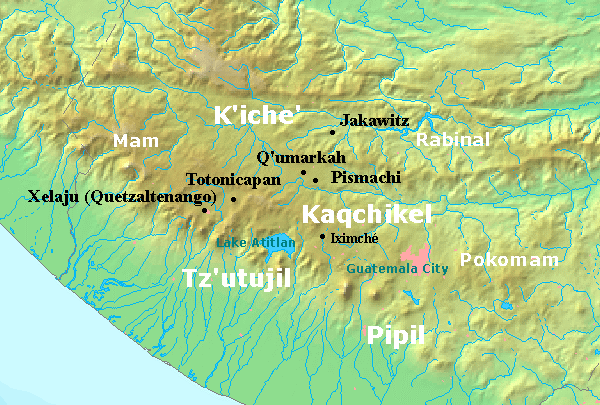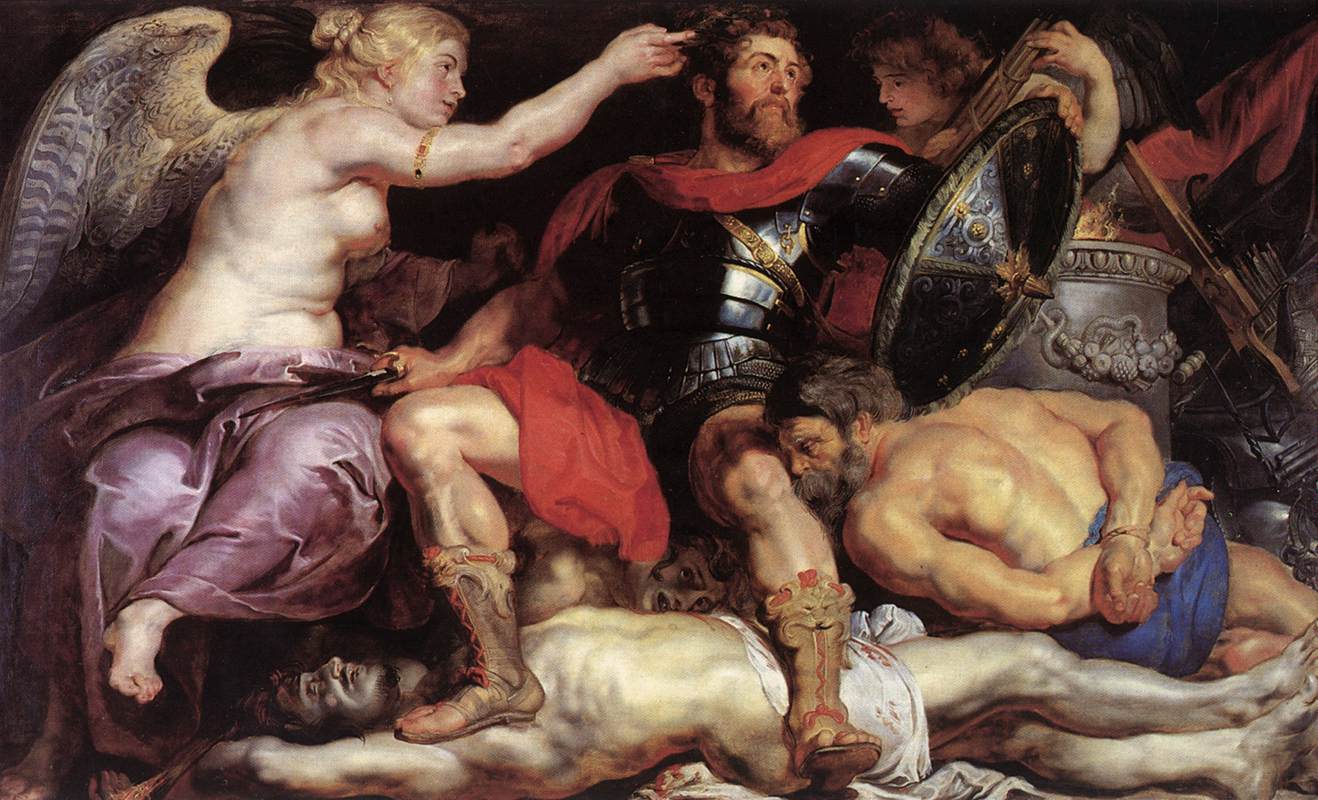|
Kʼicheʼ Kingdom Of Qʼumarkaj
The Kʼicheʼ kingdom of Qʼumarkaj was a state in the highlands of modern-day Guatemala which was founded by the Kʼicheʼ (Quiché) Maya in the thirteenth century, and which expanded through the fifteenth century until it was conquered by Spanish and Nahua forces led by Pedro de Alvarado in 1524. The Kʼicheʼ kingdom reached its height under the king Kʼiqʼab who ruled from the fortified town of Qʼumarkaj (also called by its Nahuatl name Utatlán) near the modern town of Santa Cruz del Quiché. During his rule the Kʼicheʼ ruled large areas of highland Guatemala extending into Mexico, and they subdued other Maya peoples such as the Tzʼutujil, Kaqchikel and Mam, as well as the Nahuan Pipil people. Historical sources The history of the Quiché Kingdom is described in a number of documents written in postcolonial times both in Spanish and in indigenous languages such as Classical Kʼicheʼ and Kaqchikel. Important sources include the Popol Vuh which, apart from t ... [...More Info...] [...Related Items...] OR: [Wikipedia] [Google] [Baidu] |
Conquest (military)
Conquest involves the annexation or control of another entity's territory through war or coercion. Historically, conquests occurred frequently in the international system, and there were limited normative or legal prohibitions against conquest. The onset and diffusion of nationalism (the belief that nation and state should be congruent), especially in the 19th century, made the idea of conquest increasingly unacceptable to popular opinion. Prohibitions against conquest were codified with the establishment of the League of Nations following World War I and of the United Nations at the end of World War II. Scholars have debated the strength of a norm against conquest since 1945. Conquest of large swaths of territory has been rare since the end of World War II. However, states have continued to pursue annexation of small territories. History Military history provides many examples of conquest: the Roman conquest of Britain, the Mauryan conquest of Afghanistan and of vast areas ... [...More Info...] [...Related Items...] OR: [Wikipedia] [Google] [Baidu] |
Mam People
The Mam are an Indigenous Maya people in the western highlands of Guatemala and in south-western Mexico who speak the Mam language. Most Mam (617,171) live in Guatemala, in the departments of Huehuetenango, San Marcos, and Quetzaltenango. The Mam people in Mexico (23,632) live principally in the Soconusco region of . In times the Mam were part of the |
Robert M
The name Robert is an ancient Germanic given name, from Proto-Germanic "fame" and "bright" (''Hrōþiberhtaz''). Compare Old Dutch ''Robrecht'' and Old High German ''Hrodebert'' (a compound of '' Hruod'' () "fame, glory, honour, praise, renown, godlike" and ''berht'' "bright, light, shining"). It is the second most frequently used given name of ancient Germanic origin.Reaney & Wilson, 1997. ''Dictionary of English Surnames''. Oxford University Press. It is also in use as a surname. Another commonly used form of the name is Rupert. After becoming widely used in Continental Europe, the name entered England in its Old French form ''Robert'', where an Old English cognate form (''Hrēodbēorht'', ''Hrodberht'', ''Hrēodbēorð'', ''Hrœdbœrð'', ''Hrœdberð'', ''Hrōðberχtŕ'') had existed before the Norman Conquest. The feminine version is Roberta. The Italian, Portuguese, and Spanish form is Roberto. Robert is also a common name in many Germanic languages, including En ... [...More Info...] [...Related Items...] OR: [Wikipedia] [Google] [Baidu] |
Putún Maya
Putún or Chontal Maya is a collective name for several groups of Maya that displaced much of the older leadership of the Maya Lowlands during the Late Classic and Postclassic. The Putún, who came from the Gulf coast in the northwest region of the Maya area, are generally held to have been more Mexicanized than their contemporaries. They were associated with the Puuc architectural style and distinctive orangeware pottery. The Itza are often considered a group of Putún Maya.Schele & Freidel (1990, p.497) The contemporary Chontal Maya of Tabasco Tabasco, officially the Free and Sovereign State of Tabasco, is one of the Political divisions of Mexico, 32 Federal Entities of Mexico. It is divided into Municipalities of Tabasco, 17 municipalities and its capital city is Villahermosa. It i ... speak a closely related language. Notes References * * Maya peoples {{mesoamerica-stub ... [...More Info...] [...Related Items...] OR: [Wikipedia] [Google] [Baidu] |
Rabinal
Rabinal is a small town, with a population of 15,157 (2018 census), Population of cities & towns in Guatemala located in the n department of Baja Verapaz, at . It serves as the administrative seat for the surrounding municipality of the same name. The municipality covers an area of 336 km2 with a population of 40,797 (2018 census). The local people are predominantly Achi Maya [...More Info...] [...Related Items...] OR: [Wikipedia] [Google] [Baidu] |
Pasión River
The Pasión River (, ) is a river located in the northern lowlands region of Guatemala. The river is fed by a number of upstream tributaries whose sources lie in the hills of Alta Verapaz. These flow in a general northerly direction to form the Pasión, which then tends westwards to meet up with the Salinas River at . At this confluence, the greater Usumacinta River is formed, which runs northward to its eventual outlet in the Gulf of Mexico. The Pasión River's principal tributaries are the San Juan River, the Machaquila River, and the Cancuén River. The riverine drainage system of the Pasión and its tributaries covers an area of over and forms a watershed for a substantial portion of the present-day Guatemalan department of Petén's western half. The Pasión river basin is recognized as an archaeological region or zone, and contains a number of archaeological sites of the pre-Columbian Maya civilization, which to an extent shared some commonalities in Maya architectu ... [...More Info...] [...Related Items...] OR: [Wikipedia] [Google] [Baidu] |
Título Cʼoyoi
The ''Título Cʼoyoi'' is an important early colonial Kʼiche document documenting the mythical origins of the Kʼicheʼ people and their history up to the Spanish conquest.Carmack 1973, pp. 39–40. It describes Kʼicheʼ preparations for battle against the Spanish, and the death of the Kʼicheʼ hero Tecun Uman. The document was written in Qʼumarkaj, the Kʼicheʼ capital city, by the Cʼoyoi Sakcorowach lineage, which belonged to the Quejnay branch of the Kʼicheʼ, and who held territory just to the east of Quetzaltenango, now in Guatemala. The document was largely written by Juan de Penonias de Putanza, who claimed to be the relative of a Cʼoyoi nobleman who was killed during the Spanish conquest. It was composed with the assistance of the Kʼicheʼ officialdom at Qʼumarkaj, and portions of the text reflect the official version of Kʼicheʼ history as produced in the capital. An illustration in the document shows that the Maya nobility of Quetzaltenango adopted the dou ... [...More Info...] [...Related Items...] OR: [Wikipedia] [Google] [Baidu] |
Primordial Titles
Primordial may refer to: * Primordial era, an era after the Big Bang. See Chronology of the universe * Primordial soup, hypothetical conditions under which life on Earth may have begun * Primordial nuclide, nuclides, a few radioactive, that formed before the Earth existed and are stable enough to still occur on Earth * Primordial elements, elements formed before the Earth came into existence * Primordial narcissism, the psychological condition of prenatal existence * Primordialism, the argument which contends that nations are ancient, natural phenomena * Primordial (band), Irish heavy metal band * Primordial (roller coaster), a roller coaster at Lagoon in Farmington, Utah * Primordial (album), debut studio album by American deathcore band Shadow of Intent Religion and mythology * Greek primordial deities, a group of Greek deities born in the beginning of our universe * Adi-Buddha The Ādi-Buddha (, Ch: 本佛, Jp: honbutsu, First Buddha, Original Buddha, or Primordial ... [...More Info...] [...Related Items...] OR: [Wikipedia] [Google] [Baidu] |
Annals Of The Cakchiquels
The ''Annals of the Cakchiquels'' (, also known by the alternative Spanish titles, ''Anales de los Xahil'', ''Memorial de Tecpán-Atitlán'' or ''Memorial de Sololá'') is a manuscript written in Kaqchikel by Francisco Hernández Arana Xajilá in 1571, and completed by his grandson, Francisco Rojas, in 1604. The manuscript — which describes the legends of the Kaqchikel nation and has historical and mythological components — is considered an important historical document on post-classic Maya civilization in the highlands of Guatemala. The manuscript, initially kept by the Xahil lineage in the town of Sololá in Guatemala, was later discovered in the archives of the ''San Francisco de Guatemala'' convent in 1844. It was subsequently translated by the abbot Charles Étienne Brasseur de Bourbourg in 1855 (the same translator of the Rabinal Achí), and then passed through several more hands before being published in an English translation by Daniel G. Brinton in 1885. The ... [...More Info...] [...Related Items...] OR: [Wikipedia] [Google] [Baidu] |
Título De Totonicapán
The ''Título de Totonicapán'' (Spanish for "Title of Totonicapán"), sometimes referred to as the ''Título de los Señores de Totonicapán'' ("Title of the Lords of Totonicapán") is the name given to a Kʼicheʼ language document written around 1554 in Guatemala. The ''Título de Totonicapán'' is one of the two most important surviving colonial period Kʼicheʼ language documents, together with the ''Popol Vuh''. The document contains history and legend of the Kʼicheʼ people from their mythical origins down to the reign of their most powerful king, Kʼiqʼab. History of the document In 1834 the Kʼicheʼ inhabitants of Totonicapán asked the departmental governor to persuade Dionisio José Chonay, the curate of Sacapulas, to translate the document into Spanish. The Spanish translation was archived in Totonicapán where it was found by French historian Charles Étienne Brasseur de Bourbourg in 1860. Brasseur de Bourbourg made a copy of the document and took it with him bac ... [...More Info...] [...Related Items...] OR: [Wikipedia] [Google] [Baidu] |
Popol Vuh
''Popol Vuh'' (also ''Popul Vuh'' or ''Pop Vuj'') is a text recounting the mythology and history of the Kʼicheʼ people of Guatemala, one of the Maya peoples who also inhabit the Mexican states of Chiapas, Campeche, Yucatan and Quintana Roo, as well as areas of Belize, Honduras and El Salvador. The ''Popol Vuh'' is a foundational sacred narrative of the Kʼich'eʼ people from long before the Spanish conquest of the Maya. It includes the Mayan creation myth, the exploits of the Maya Hero Twins, Hero Twins Hunahpú and Xbalanqué, and a chronicle of the Kʼicheʼ people. The name "''Popol Vuh''" translates as "Book of the Community" or "Book of Counsel" (literally "Book that pertains to the mat", since a woven mat was used as a royal throne in ancient Kʼicheʼ society and symbolised the unity of the community). It was originally preserved through oral tradition until approximately 1550, when it was recorded in writing. The documentation of the ''Popol Vuh'' is credited to the ... [...More Info...] [...Related Items...] OR: [Wikipedia] [Google] [Baidu] |




